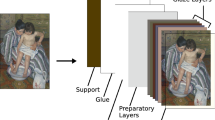Abstract
Fluorosilicone o-rings with varying levels of compression set were investigated with a variety of methods. Low field NMR experiments were able to elucidate if the sample had taken a compression set; however, this technique did not have the sensitivity to quantify the relative level of compression set of the o-ring. Water sorption isotherms probe the interior void structure through void space occupation and while complex, the sorption isotherms indicate a systematic loss of void volume with increasing compression set. Similarly, variable temperature 129Xe NMR experiments indicate an elimination of macroscopic void space with increasing compression. The NMR techniques, being noninvasive, have a unique ability to assess the service status of an o-ring in real time.
Similar content being viewed by others
References
Bernstein R, Gillen K (2009) Predicting the lifetime of fluorosilicone o-rings. Polym Degrad Stab 94(12):2107–2113. doi:10.1016/j.polymdegradstab.2009.10.005. http://www.sciencedirect.com/science/article/pii/S0141391009003309
Chinn SC, Herberg JL, Sawvel AM, Maxwell RS (2004) Solid state nmr measurements for preliminary lifetime assessments in gamma-irradiated and thermally aged siloxane elastomers. In: MRS Proceedings, vol 851
Graiver D, Farminer K, Narayan R (2003) A review of the fate and effects of silicones in the environment. J Environ Polym Degr 11:129–136. doi:10.1023/A:1026056129717
Harley SJ, Glascoe EA, Maxwell RS (2012) Thermodynamic study on dynamic water vapor sorption in sylgard-184. J Phys Chem B 116(48):14,183–14,190. doi:10.1021/jp305997f
Jeener J, Du Bois R, Broekaert P (1965) “zeeman” and “dipolar” spin temperatures during a strong rf irradiation. Phys Rev 139:A1959–A1961. doi:10.1103/PhysRev.139.A1959
Khalfaoui M, Knani S, Hachicha M, Lamine A (2003) New theoretical expressions for the five adsorption type isotherms classified by bet based on statistical physics treatment. J Colloid Interface Sci 263(2):350–356. doi:10.1016/S0021-9797(03)00139-5. http://www.sciencedirect.com/science/article/pii/S0021979703001395
Maxwell RS, Chinn SC, Solyom D, Cohenour R (2005) Radiation-induced cross-linking in a silica-filled silicone elastomer as investigated by multiple quantum h-1 nmr 38(16):7026–7032. ⟨GotoISI⟩://000230978500040
Pierce OR, Holbrook GW, Johannson OK, Saylor JC, Brown ED (1960) Fluorosilicone rubber. Ind Eng Chem 52(9):783–784. doi:10.1021/ie50609a030
Pierce OR, Kim YK (1971) Fluorosilicones as high temperature elastomers. Rubber Chem Technol 44(5):1350–1362. doi:10.5254/1.3544816
Polyzois GL, Hensten-Pettersen A, Kullmann A (1994) An assessment of the physical properties and biocompatibility of three silicone elastomers. J Prosthet Dent 71(5):500–504. doi:10.1016/0022-3913(94)90190-2. http://www.sciencedirect.com/science/article/pii/0022391394901902
Scala L, Hickam W (1958) Thermal and oxidative degradation of silicones. Ind Eng Chem 50(10):1583–1584. doi:10.1021/ie50586a046
Springuel-Huet MA, Bonardet JL, Fraissard J (1995) 129xe-nmr of physisorbed xenon used as a probe for the study of microporous solids. Appl Magn Reson 8:427–456. doi:10.1007/BF03162656
Turri S, Levi M, Cristini M, Sanguineti A (2007) Dynamic and thermo-mechanical properties of some specialtyfluoroelastomers for low tg seal materials. J Polym Res 14:141–145. doi:10.1007/s10965-006-9093-3
Watson J, Baron M (1996) The behaviour of water in poly(dimethylsiloxane). J Membr Sci 110(1):47–57. doi:10.1016/0376-7388(95)00229-4 10.1016/0376-7388(95)00229-4. http://www.sciencedirect.com/science/article/pii/0376738895002294
Yokoyama K, Okazaki M, Komito T (1998) Effect of contact pressure and thermal degradation on the sealability of o-ring. JSAE Rev 19(2):123–128. doi:10.1016/S0389-4304(97)00070-2. http://www.sciencedirect.com/science/article/pii/S0389430497000702
Zielecka M, Bujnowska E (2006) Silicone-containing polymer matrices as protective coatings: Properties and applications. In: Progress in Organic Coatings. Coatings Science International Conference Program, vol 55(2), pp 160–167, doi:10.1016/j.porgcoat.2005.09.012. http://www.sciencedirect.com/science/article/pii/S0300944005002225
Author information
Authors and Affiliations
Corresponding author
Rights and permissions
About this article
Cite this article
Harley, S.J., Mayer, B.P., Glascoe, E.A. et al. Multi-Method Characterization of Compression Set in Fluorosilicone O-Rings. Silicon 11, 2225–2231 (2019). https://doi.org/10.1007/s12633-014-9255-6
Received:
Accepted:
Published:
Issue Date:
DOI: https://doi.org/10.1007/s12633-014-9255-6




